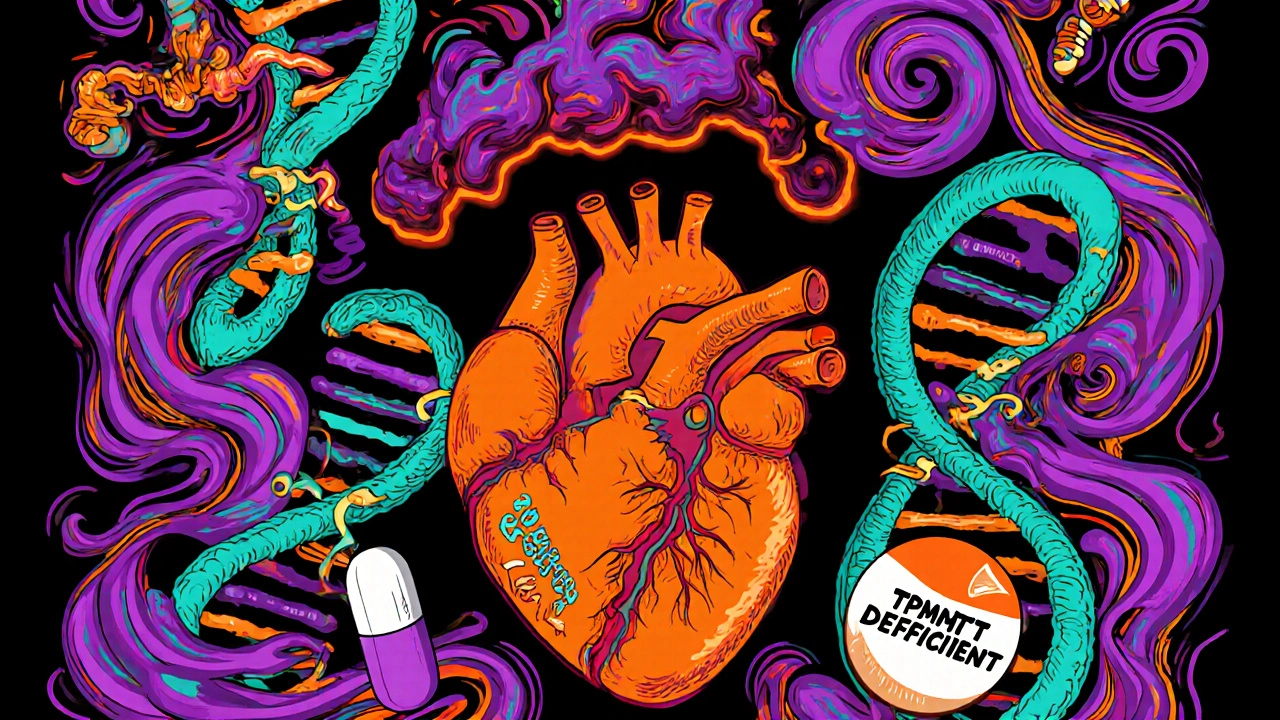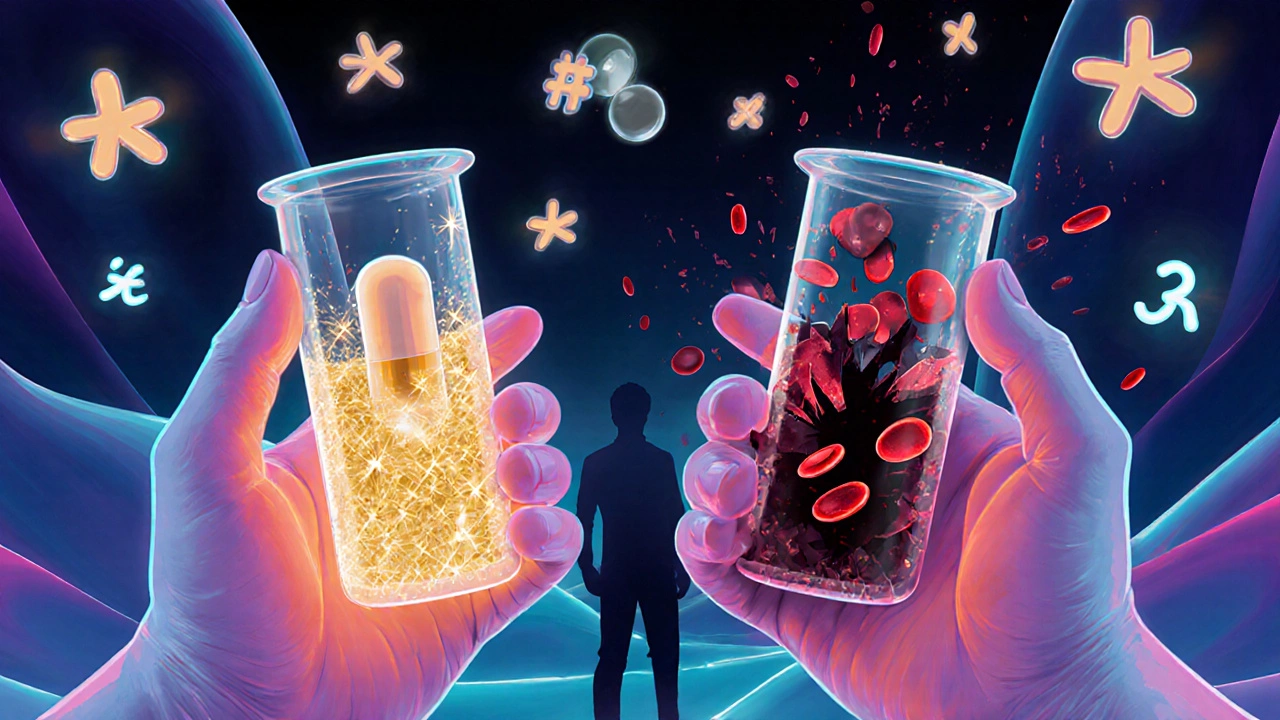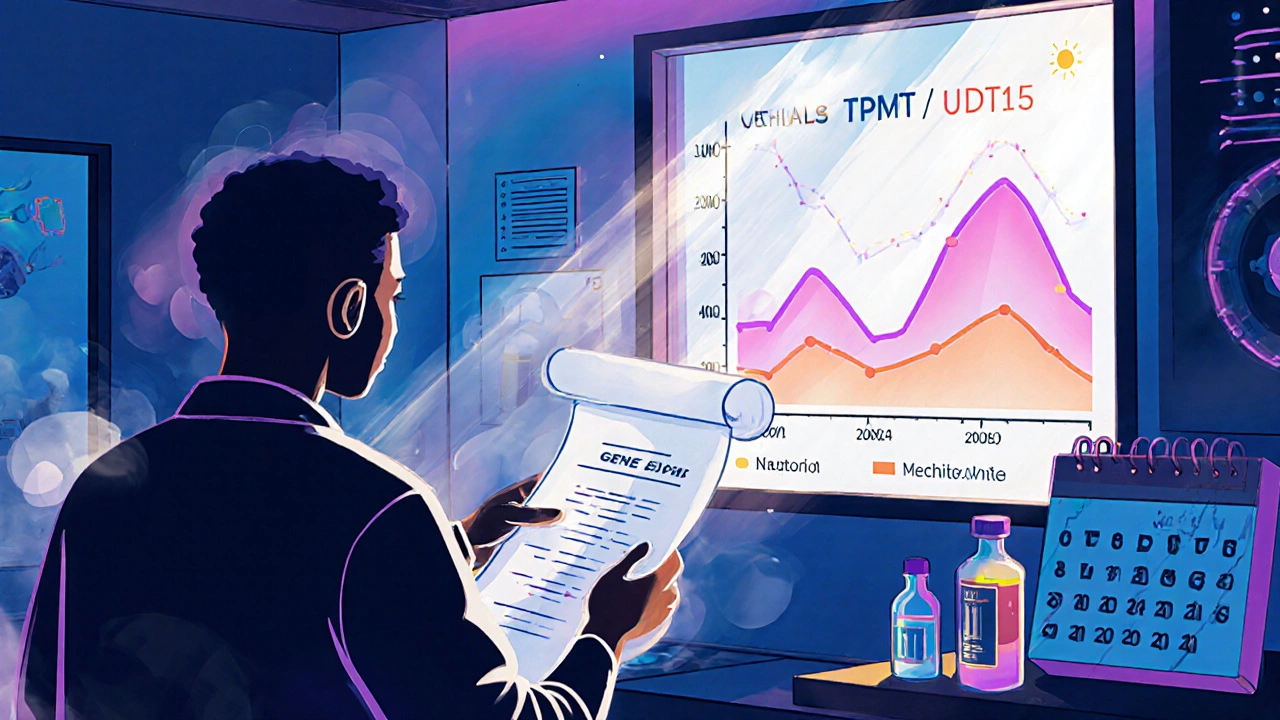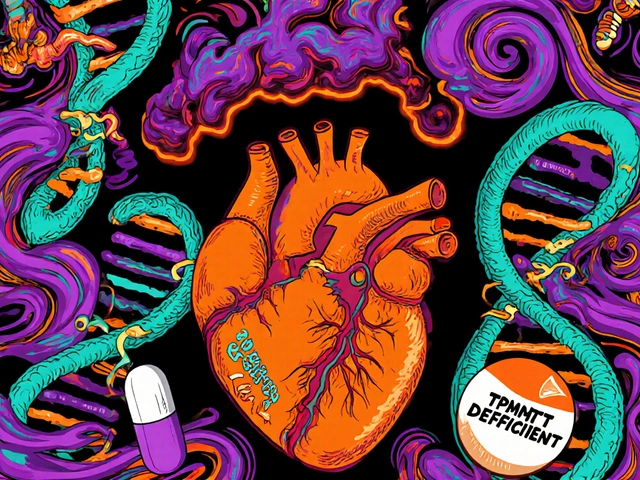
Azathioprine Dose Adjustment Calculator
Calculate Your Safe Azathioprine Dose
This tool adjusts azathioprine dosage based on your TPMT genetic status and ethnicity to prevent life-threatening side effects. Always consult your doctor before starting medication.
Why This Matters
0.3% of people have homozygous TPMT deficiency—they should NOT take azathioprine due to high risk of fatal bone marrow suppression.
10% of people have heterozygous deficiency—they need 30-70% dose reduction to avoid severe side effects.
Important: TPMT testing alone isn't enough. Up to 20% of people of Asian descent have NUDT15 deficiency which causes severe toxicity. We recommend NUDT15 testing if you're of Asian heritage.
When you're prescribed azathioprine for Crohn’s disease, lupus, or after an organ transplant, you’re not just taking a pill-you’re trusting your body to handle a powerful drug that can save your life… or nearly end it. About 1 in 300 people have a genetic quirk that makes azathioprine dangerously toxic. For them, even a standard dose can crash their blood cell counts, leading to infections, bleeding, or death. The good news? There’s a simple test-TPMT testing-that can spot this risk before you even take your first pill.
What Is Azathioprine and Why Does It Need a Genetic Check?
Azathioprine is an old-school immunosuppressant, first used in the 1960s. It’s cheap-often under $50 a month-and works well for long-term control of autoimmune diseases. But it doesn’t play nice with everyone. About 15% to 28% of people on azathioprine have side effects, and the worst one is myelosuppression: your bone marrow stops making enough white blood cells, red blood cells, and platelets. That’s not just a lab result-it’s a medical emergency.
Why does this happen? Because your body breaks down azathioprine using an enzyme called TPMT (thiopurine methyltransferase). Some people are born with genes that make this enzyme weak or broken. If you have two bad copies (homozygous), your body can’t process the drug at all. It builds up like poison. About 0.3% of people in the U.S. fall into this category. Another 10% have one bad copy (heterozygous), meaning they process the drug slower. For them, the standard dose is too much.
How TPMT Testing Works: Genes vs. Enzymes
There are two ways to test for TPMT status: genotyping and phenotyping. Genotyping looks at your DNA for specific gene variants like *2, *3A, *3B, and *3C. It’s accurate, fast, and not affected by recent blood transfusions. Phenotyping measures the actual enzyme activity in your red blood cells. But if you’ve had a transfusion in the last few months, your results can be wrong-your donor’s enzymes are what’s being measured, not yours.
Most clinics now use genotyping because it’s more reliable. Results come back in 3 to 7 days. The test doesn’t just tell you if you’re at risk-it tells you how much risk. If you’re homozygous deficient, you’re not a candidate for azathioprine. Period. Your doctor will switch you to methotrexate or a biologic. If you’re heterozygous, you can still take azathioprine, but you’ll start at 30% to 70% of the normal dose. That’s often 50 mg instead of 100 mg. Weekly blood tests for the first month keep you safe.
Why TPMT Testing Isn’t a Magic Bullet
Here’s the catch: TPMT testing doesn’t prevent all side effects. A 2011 study with 333 patients found that even with testing, 29% still had adverse reactions-almost the same as the group without testing. Why? Because azathioprine toxicity isn’t just about TPMT. Other genes matter too, especially NUDT15.
NUDT15 is a newer player. It’s especially important for people of Asian descent. Up to 20% of Asian populations have variants that make them ultra-sensitive to azathioprine. In fact, for many in this group, NUDT15 deficiency causes more toxicity than TPMT. That’s why guidelines updated in 2022 now recommend testing for both. If you’re of Asian heritage, asking for NUDT15 testing isn’t optional-it’s smart.
And then there are drug interactions. If you’re taking allopurinol (for gout), your risk of toxicity skyrockets-even if your TPMT is normal. The same goes for ACE inhibitors and some antibiotics. Your liver and kidneys also play a role. If they’re not working well, the drug lingers longer. That’s why doctors still check your blood counts every week at first, even if your test results are clean.

Real Stories: When Testing Made All the Difference
One patient with ulcerative colitis had a TPMT test that showed intermediate activity. Her doctor cut her dose in half-from 100 mg to 50 mg. Six months later, her white blood cell count stayed normal. Her friend, who skipped testing and started at the full dose, developed severe leukopenia and had to stop the drug entirely.
But another patient, with normal TPMT, developed liver damage after three months. He didn’t know his 6-MMP levels were too high-a different metabolic pathway gone wrong. His story proves testing isn’t foolproof. About 7.4% of people on azathioprine get liver toxicity, and it’s not always tied to TPMT. That’s why doctors still check liver enzymes every month.
On patient forums, people talk about nausea-it’s the most common side effect. But it’s usually mild and goes away. The real danger is silent: no symptoms until your blood count drops dangerously low. That’s why testing and monitoring go hand in hand.
What Doctors Really Do: Guidelines vs. Reality
The American Gastroenterological Association says TPMT testing should be done before starting azathioprine. The European Crohn’s and Colitis Organisation calls it “recommended,” not mandatory. In U.S. academic centers, about 60% of doctors order the test. In community clinics? Maybe 30%. Why the gap? Cost. The test runs $200 to $400. Insurance usually covers it, but not always, especially with Medicaid.
Some doctors think: “I’ll just monitor blood counts anyway.” That’s true-but monitoring catches problems after they start. Testing prevents them before they happen. For the 0.3% with homozygous deficiency, skipping the test is like playing Russian roulette with your bone marrow.
And here’s something most patients don’t know: azathioprine can make your skin burn in the sun. Photosensitivity is real. Wear sunscreen. Wear long sleeves. It’s not in the brochure, but it’s in the research.

What Comes Next: The Future of Testing
Pharmacogenomics is moving fast. Companies like OneOme and GeneSight now offer multi-gene panels that test for TPMT, NUDT15, and other variants in one go. The FDA updated azathioprine’s label in 2019 to include both genes. More insurers are covering these panels. In five years, it may be standard to test for all known risk variants before starting any thiopurine drug.
For now, the message is clear: if you’re about to start azathioprine, ask for TPMT and NUDT15 testing. Don’t assume your doctor will order it. Bring it up. If they say no, ask why. If cost is an issue, ask about financial aid-many labs offer discounts.
Azathioprine is a powerful tool. It’s saved thousands of lives. But it’s not a one-size-fits-all drug. Your genes matter. Your other medications matter. Your liver and kidneys matter. Testing doesn’t guarantee safety-but it gives you the best shot at avoiding disaster.
What to Do Before Starting Azathioprine
- Ask for TPMT and NUDT15 genetic testing before your first dose.
- If you’re of Asian descent, insist on NUDT15 testing.
- Tell your doctor about every medication you take-especially allopurinol, ACE inhibitors, or antibiotics.
- Get a baseline CBC and liver function test before starting.
- Plan for weekly blood tests for the first month, then monthly after that.
- Use sunscreen daily and avoid prolonged sun exposure.
- Know the signs of low blood counts: fatigue, fever, unexplained bruising, or frequent infections.
Is TPMT testing required before taking azathioprine?
No, it’s not legally required, but major medical groups like the American Gastroenterological Association strongly recommend it. Skipping it puts you at risk of life-threatening low blood counts, especially if you have two defective copies of the TPMT gene. Many doctors now order it as standard practice.
Can I take azathioprine if my TPMT test shows low activity?
If your TPMT activity is severely low (homozygous deficient), you should not take azathioprine. The risk of fatal bone marrow suppression is too high. Your doctor will switch you to methotrexate, a biologic like infliximab, or another alternative. If your activity is only low-intermediate (heterozygous), you can take it-but at a reduced dose, with close monitoring.
Does NUDT15 testing replace TPMT testing?
No. They test for different genetic risks. TPMT is the most common in people of European descent, while NUDT15 is more relevant in Asian, Hispanic, and Indigenous populations. Experts now recommend testing for both, especially if you have ancestry from Asia. Some labs now offer combined panels.
How long does it take to get TPMT test results?
Most results come back in 3 to 7 days. Some labs offer expedited testing for $50 extra. If you’re in a hurry, ask your doctor if they can order a rapid genotyping test. Don’t start azathioprine until you have the results-waiting a week is safer than risking a hospital stay.
If my TPMT test is normal, can I skip blood tests?
Absolutely not. TPMT testing only covers one part of the risk. You can still develop liver damage, pancreatitis, or low blood counts due to other genes, drug interactions, or kidney issues. The NCBI and FDA both state that blood tests (CBC and liver enzymes) are mandatory during treatment. Testing and monitoring work together-they’re not alternatives.
What if my doctor says TPMT testing is too expensive?
Ask if your insurance covers it-most commercial insurers do. If you’re on Medicaid, coverage varies. Many labs offer patient assistance programs or reduced rates. The cost of a hospital stay for severe myelosuppression can be over $50,000. The $300 test is a small price to avoid that. You can also ask your pharmacy or clinic if they have a partnership with a testing provider.
Can I get tested for TPMT and NUDT15 before I’m prescribed azathioprine?
Yes. Some genetic testing companies offer direct-to-consumer pharmacogenomic panels that include TPMT and NUDT15. These aren’t covered by insurance unless ordered by a doctor, but they can be useful if you know you might need immunosuppressants in the future-like if you have a family history of autoimmune disease. Talk to your doctor about getting a baseline test done proactively.


I had TPMT testing done before starting azathioprine for my Crohn’s. My doc didn’t even mention it, so I asked. Turned out I was heterozygous. They cut my dose to 50mg and I’ve been fine for two years now. Seriously, don’t wait for symptoms-get tested.
This is such an important topic. 💙 So many people don’t realize how much genetics can impact medication safety. I’m so glad we’re moving toward personalized medicine. If you’re on azathioprine or thinking about it-please, please ask for the test. It’s not just smart, it’s life-saving.
My cousin skipped the test and ended up in the hospital with a WBC count of 0.8. She was lucky she got help in time. Now she’s on methotrexate and doing way better. I told my rheumatologist I want both TPMT and NUDT15 tested before I even think about starting anything. No more guessing games.
TPMT testing is standard. Not optional. If your doctor doesn’t order it, ask why. Then ask again. Then get a second opinion.
Just got my NUDT15 results back last week-turns out I’m a carrier. My doc was like, ‘Oh yeah, we should’ve tested that too.’ 😅 I’m from the Philippines, so this makes total sense. Now I’m on a lower dose and feeling great. Pro tip: if you’re Asian, don’t let them skip NUDT15. It’s not extra-it’s essential. 🙌
If you’re on azathioprine and haven’t had testing, you’re playing Russian roulette with your bone marrow. Period. I’ve seen too many patients crash. This isn’t theoretical. It’s clinical reality. Get the test. Do it now. Don’t wait for your first fever or bruise.
It’s fascinating, isn’t it? The entire edifice of modern pharmacology-built on the illusion of universality-collapses under the weight of individual genetic variance. We’ve been treating humans like they’re all the same machine, when in truth, our biochemistry is as unique as our fingerprints. Azathioprine is merely the latest revelation in a long, tragic history of medical hubris. We test for TPMT now… but what about the other 17 genes we haven’t even named yet? When will we stop pretending we know what we’re doing?
From a pharmacokinetic standpoint, the TPMT/NUDT15 pathway is critical for thiopurine metabolism. But the clinical implications extend beyond genotyping-drug-drug interactions, hepatic function, and renal clearance all modulate bioavailability. A normal TPMT result doesn’t negate the need for serial CBCs and LFTs. The FDA’s 2019 label update reflects this multi-factorial risk architecture.
Let’s be honest: TPMT testing is a band-aid. The real issue is that we’re still using a 1960s drug with a narrow therapeutic index. Why not just use biologics from the start? They’re more expensive, yes-but they’re safer, more predictable, and don’t require genetic detective work. We’re optimizing the wrong thing.
My grandma had Crohn’s in the 80s and took azathioprine without any testing. She lived to 89, but she had three hospital stays from low blood counts. I’m 32 and just started the drug. I asked for both tests-my doc rolled his eyes but did it. Turned out I’m normal for both. Still, I’m doing weekly bloodwork. Better safe than sorry. And yes, I wear sunscreen like it’s my job now 😅
My brother got his test results back and they said 'intermediate activity'-so they cut his dose. He’s been on it for a year and hasn’t had a single issue. I wish more people knew this stuff. It’s not complicated. Just ask. No shame in being proactive.
Just had the test done. Low activity. Doc switched me to methotrexate. Best decision ever. No more scary blood draws. No more panic when I get a cold. Life’s better now.
Wow. So you’re telling me I could’ve died because my doctor didn’t order a $300 test? That’s wild. I’m gonna send this to every person I know who’s on immunosuppressants. Seriously, if you’re reading this and you’re on azathioprine-go ask for the test right now. I’ll wait.